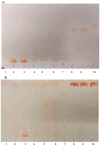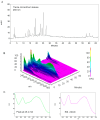Does Trema micranthum (L.) Blume Produce Cannabinoids?
- PMID: 39065478
- PMCID: PMC11281079
- DOI: 10.3390/plants13141951
Does Trema micranthum (L.) Blume Produce Cannabinoids?
Abstract
There are inconclusive claims in the scientific literature that the species Trema micranthum, widely distributed throughout the Brazilian territory, may produce phytocannabinoids, potentially serving as an alternative to Cannabis sativa. In this study, we conducted a comprehensive investigation to assess the presence of phytocannabinoids in two Trema micranthum samples collected in the Midwest region of Brazil. In trying to detect cannabinoids in T. micranthum, a recommended cannabis screening test was employed, the Fast Blue BB Salt (FBBBS) colorimetric assay, followed by thin-layer chromatography (TLC) and instrumental techniques: high-performance liquid chromatography coupled to diode array detector (HPLC-DAD) and gas chromatography coupled to mass spectrometry (GC-MS). When employed without chloroform extraction, the FBBBS reagent yielded positive results for extracts from all parts of T. micranthum (leaves, branches, fruits, and inflorescences). However, these initial positive results from the FBBBS test, suggesting the presence of cannabinoids, were not corroborated by FBBBS followed by chloroform extraction, TLC, or the instrumental techniques used in this study. These additional outcomes suggest that the positive FBBBS test results were likely due to the presence of other phenolic compounds rather than phytocannabinoids. For example, the presence of vitexin-like compounds in T. micranthum extracts might explain the positive FBBBS test results. Therefore, new assertions that T. micranthum produces cannabinoids will require the support of more selective experiments to avoid false-positive claims based on less selective screening tests.
Keywords: Cannabaceae; FBBBS; cannabidiol; phytocannabinoids.
Conflict of interest statement
The authors declare no conflicts of interest.
Figures









Similar articles
-
Trema micranthum (L.) Blume as a new source of cannabinoids.Sci Rep. 2024 Nov 28;14(1):29620. doi: 10.1038/s41598-024-80857-6. Sci Rep. 2024. PMID: 39609538 Free PMC article.
-
Cannabinoids From Trema micranthum (L.) Blume (Cannabaceae): A Cannabinoid Profiling System.Chem Biodivers. 2025 May 22:e00208. doi: 10.1002/cbdv.202500208. Online ahead of print. Chem Biodivers. 2025. PMID: 40403289
-
Cannabinoids from inflorescences fractions of Trema orientalis (L.) Blume (Cannabaceae) against human pathogenic bacteria.PeerJ. 2021 May 13;9:e11446. doi: 10.7717/peerj.11446. eCollection 2021. PeerJ. 2021. PMID: 34035994 Free PMC article.
-
Application of gas chromatography in the analysis of phytocannabinoids: An update (2020-2023).Phytochem Anal. 2023 Dec;34(8):903-924. doi: 10.1002/pca.3303. Epub 2023 Nov 14. Phytochem Anal. 2023. PMID: 37963411 Review.
-
Biosynthetic origins of unusual cannabimimetic phytocannabinoids in Cannabis sativa L: A review.Phytochemistry. 2022 Sep;201:113282. doi: 10.1016/j.phytochem.2022.113282. Epub 2022 Jun 16. Phytochemistry. 2022. PMID: 35718133 Review.
Cited by
-
Trema micranthum (L.) Blume as a new source of cannabinoids.Sci Rep. 2024 Nov 28;14(1):29620. doi: 10.1038/s41598-024-80857-6. Sci Rep. 2024. PMID: 39609538 Free PMC article.
-
Recent HPLC-UV Approaches for Cannabinoid Analysis: From Extraction to Method Validation and Quantification Compliance.Pharmaceuticals (Basel). 2025 May 24;18(6):786. doi: 10.3390/ph18060786. Pharmaceuticals (Basel). 2025. PMID: 40573182 Free PMC article. Review.
References
-
- Harry G.J. Cannabinoids. In: Slikker W., Aschner M., Costa L.G., editors. Advances in Neurotoxicology. Volume 8. Academic Press; Cambridge, MA, USA: 2022. pp. 1–48.
-
- UN . Treaty Series 1566. United Nations Office of Legal Affairs; New York, NY, USA: 1999. Single convention on narcotic drugs, 1961. Done at New York on 30 March 1961. Number 7515.
-
- UN . The International Drug Control Conventions Schedules of the Single Convention on Narcotic Drugs of 1961 as Amended by the 1972 Protocol, as at 22 January 2021. United Nations; New York, NY, USA: 2021.
Grants and funding
- 001/Coordenação de Aperfeicoamento de Pessoal de Nível Superior
- scholarship PIBIC/National Council for Scientific and Technological Development
- Scholarship PIBIC/Fundação de Apoio à Pesquisa do Distrito Federal -FAP-DF
- apoio a pesquisa/Universidade de Brasilia
- resources/Instituto de Criminalistica da Policia Civil do Distrito Federal
LinkOut - more resources
Full Text Sources
Miscellaneous

